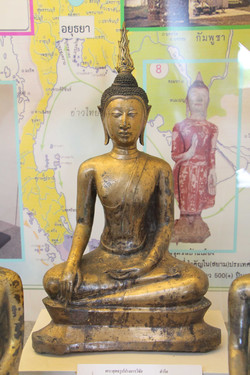ค้นหางานศิลปกรรม
ฐานข้อมูลศิลปกรรมในเอเชียตะวันออกเฉียงใต้
พระพุทธรูปปางมารวิชัย
คำสำคัญ : วัดราชบูรณะ, พระพุทธรูป, พระพุทธรูปปางมารวิชัย, พิพิธภัณฑสถานแห่งชาติ เจ้าสามพระยา
| ชื่อหลัก | พิพิธภัณฑสถานแห่งชาติ เจ้าสามพระยา |
|---|---|
| ประเภทงานศิลปะ | ประติมากรรม |
| ตำบล | ประตูชัย |
| อำเภอ | พระนครศรีอยุธยา |
| จังหวัด | พระนครศรีอยุธยา |
| ภาค | ภาคกลาง |
| ประเทศ | ไทย |
| พิกัดภูมิศาสตร์ ค่าองศาทศนิยม | Lat : 14.350887 Long : 100.561788 |
| พิกัดภูมิศาสตร์ พิกัดกริด | Zone : 47 P Hemisphere : N E : 668418.08 N : 1587102.32 |
| ตำแหน่งงานศิลปะ | จัดแสดงในพิพิธภัณฑสถานแห่งชาติ เจ้าสามพระยา |
| ประวัติการสร้าง | ไม่พบหลักฐานลายลักษณ์อักษรเอ่ยถึงการสร้างพระพุทธรูปองค์นี้โดยตรง แต่จากการค้นพบภายในกรุพระปรางค์วัดราชบูรณะที่พระราชพงศาวดารฉบับหลวงประเสริฐอักษรนิติ์ระบุว่าสร้างขึ้นเมื่อ พ.ศ.1967 รัชกาลสมเด็จพระบรมราชาธิราชที่ 2 หรือเจ้าสามพระยา ย่อมเป็นหลักฐานว่าพระพุทธรูปองค์นี้ย่อมสร้างขึ้นอย่างช้าในศักราชนี้ (พระราชพงศาวดารบางฉบับระบุว่าวัดนี้สร้างขึ้น พ.ศ. 1961) พระพุทธรูปที่มีพุทธลักษณะเช่นองค์นี้ซึ่งเรียกกันว่า พระพุทธรูปอู่ทองรุ่นที่ 3 พบได้มากในกรุพระปรางค์วัดราชบูรณะ ทำให้เชื่อกันว่าน่าจะนิยมแพร่หลายในราวกลางพุทธศตวรรษที่ 20 |
|---|---|
| กระบวนการสร้าง/ผลิต | หล่อสำริด |
| ลักษณะทางศิลปกรรม | พระพุทธรูปอยู่ในอิริยาบถนั่งขัดสมาธิราบปางมารวิชัยบนฐานบัวที่ไม่มีการประดับตกแต่งใดๆ รูปแบบในภาพรวมสะท้อนถึงการสืบต่อจากพระพุทธรูปรุ่นก่อนกรุงศรีอยุธยา-อยุธยาตอนต้น หรือพระพุทธรูปอู่ทองรุ่นที่ 1 และรุ่นที่ 2 ในขณะเดียวกันก็มีความสัมพันธ์กับพระพุทธรูปหมวดใหญ่ในศิลปะสุโขทัยด้วย รูปแบบสำคัญของพระพุทธรูปองค์นี้ที่สืบต่อจากพระพุทธรูปอู่ทองรุ่นที่ 1 และ 2 ได้แก่ นั่งขัดสมาธิราบพระหัตถ์ทำปางมารวิชัยอยู่บนฐานบัวเกลี้ยงๆ เม็ดพระศกเทียบได้ดังหนามขนุน ส่วนความสัมพันธ์กับพระพุทธรูปสุโขทัยเห็นได้จากพระรัศมีรูปเปลวไฟ พระพักตร์วงรูปไข่ พระขนงโก่งโค้ง แม้มีไรพระศกเช่นพระพุทธรูปอู่ทอง แต่การหยักแหลมที่กึ่งกลางพระนลาฏล้อตามความโก่งโค้งของพระขนงและบริเวณพระกรรเจียก (ขมับ) ไม่หยักแหลม ย่อมสัมพันธ์กับแนวพระเกศาในพระพุทธรูปศิลปะสุโขทัยหมวดใหญ่ พระพุทธรูปองค์นี้ครองจีวรห่มเฉียง ชายสังฆาฏิหรือชายจีวรเป็นแถบสี่เหลี่ยมพาดผ่านพระอังสาซ้ายยาวจรดพระนาภี ปลายตัดตรง พระหัตถ์ขวาวางอยู่บริเวณพระชงฆ์มีความอ่อนช้อยกว่าพระพุธรูปอู่ทองรุ่นที่ 1 และ 2 ซึ่งน่าจะเป็นอีกประเด็นหนึ่งที่สัมพันธ์กับพระพุทธรูปสุโขทัย |
| ข้อมูลที่สำคัญทางวิชาการ | พระพุทธรูปองค์นี้เป็นตัวอย่างของพระพุทธรูปแบบอู่ทองรุ่นที่ 3 อันมีรูปแบบสืบต่อศิลปกรรมลุ่มแม่น้ำภาคกลางตอนล่าง ทั้งอู่ทองรุ่นที่ 1 และรุ่นที่ 2 ผสมผสานกับแรงบันดาลใจจากภาคกลางตอนบนหรือสุโขทัย พระพุทธรูปอู่ทองรุ่นที่ 3 พบมากในกรุพระปรางค์วัดราชบูรณะ ซึ่งรวมถึงพระพุทธรูปองค์นี้ด้วย เป็นวัดที่สร้างขึ้นในสมัยสมเด็จพระบรมราชาธิราชที่ 2 หรือเจ้าสามพระยา พ.ศ.1967 สะท้อนให้เห็นว่าช่วงระยะเวลานี้ความสัมพันธ์กับสุโขทัยได้ส่งผลต่อพุทธศิลป์อยุธยาตอนต้นด้วย |
| ข้อสังเกตอื่นๆ | พระพุทธรูปที่มีพุทธลักษณะเช่นนี้ตรงกับที่นักวิชาการกำหนดเรียกว่า พระพุทธรูปแบบอู่ทองรุ่นที่ 3 |
| ยุค | ประวัติศาสตร์ |
| สมัย/รูปแบบศิลปะ | อยุธยา |
| อายุ | กลางพุทธศตวรรษที่ 20 |
| ศาสนา | พุทธ |
| ศาสนา/ความเชื่อที่เกี่ยวข้อง | พุทธศาสนา |
| รูปแบบลิขสิทธิ์ | Attribution-NonCommercial-NoDerivs (CC BY-NC-ND) |
|---|---|
| เจ้าของสิทธิ์ | ศูนย์มานุษยวิทยาสิรินธร (องค์การมหาชน) |
| วันที่จัดทำข้อมูล | 2016-09-30 |
| ผู้จัดทำข้อมูล | รุ่งโรจน์ ธรรมรุ่งเรือง |
| บรรณานุกรม | ศักดิ์ชัย สายสิงห์. พระพุทธรูปในประเทศไทย รูปแบบ พัฒนาการ และความเชื่อของคนไทย. กรุงเทพฯ : ภาควิชาประวัติศาสตร์ศิลปะ คณะโบราณคดี มหาวิทยาลัยศิลปากร, 2556. สันติ เล็กสุขุม. ศิลปะอยุธยา: งานช่างหลวงแห่งแผ่นดิน. พิมพ์ครั้งที่ 3, กรุงเทพฯ : เมืองโบราณ, 2550. |


